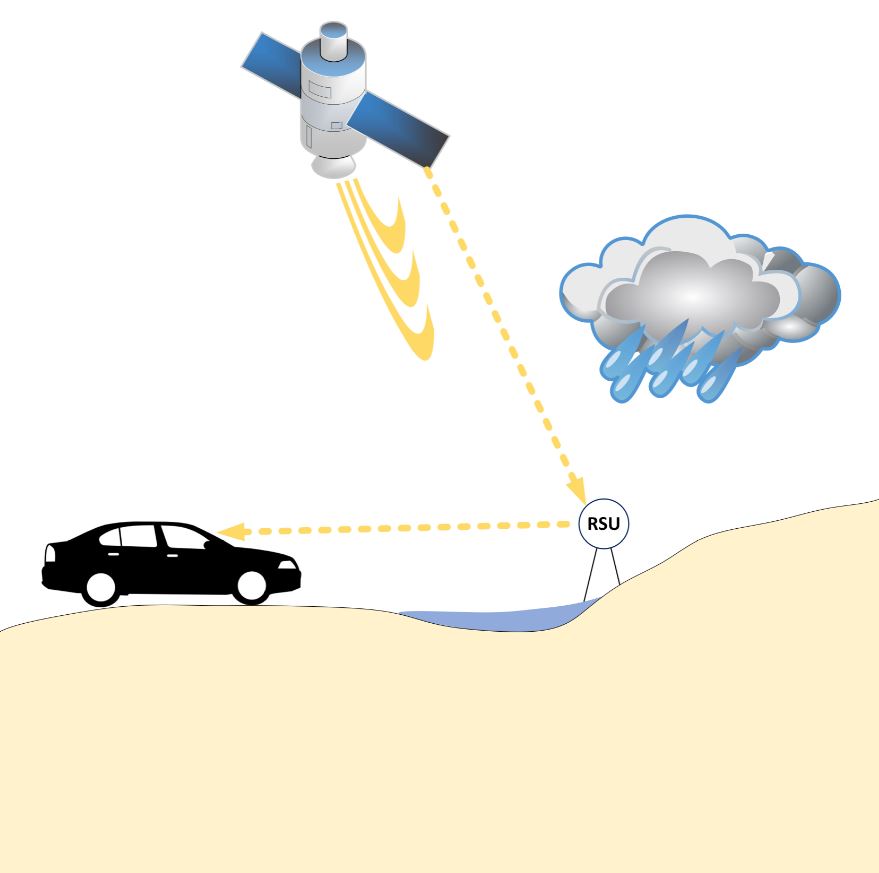
Abstract
The goal of the proposed project is to systematically extract traffic safety information from multiple complex sources of flood monitoring such as remote sensing technologies, flow gages, and weather stations, which can support informed planning for transportation safety against flooding in future smart cities. Flooding poses a significant hazard to the moving vehicles and causes traffic disruption by placing water flow in the transportation network, resulting in sweeping vehicles away, injuries and loss of life of passengers. While different methods to continuously monitor flooding are available in the field of flood management, the collected data is too complex to directly offer relevant information for transportation safety. As a result, the application of flood monitoring in Connected Vehicles has been limited to weather information, which does not directly relate to transportation safety. To fill this gap, we will employ Big Data Analytics to extract transportation safety information from multiple monitoring sources, each of which continuously collect data in a fine temporal scale. Our approach, as an example application, will provide a decision support system to identify and prioritize candidate locations for future installation of roadside units. To facilitate visualization of our findings for an enhanced technology transfer, we will define metrics following the risk assessment of flooding in transportation network. Consequently, we will develop regional “heat maps” to visualize such metrics across large geographic scales, including communities that are disadvantaged.
Project Highlights
- This project synthesized several approaches to build an understanding of the spatial extent of urban flooding in the frequently flooded parts of San Diego’s transportation network, many of which are disadvantaged communities.
- We used flooding reported during major storms as validation data for a Generalized Linear Regression model to create a map of flood risk. Then, a Support Vector Machine model was used to extract areas of possible flooding from a satellite image.
- This project was able to engage multiple stakeholders across the US through a webinar for transferring knowledge on our findings for informed future design of transportation network considering the flooding risks. This webinar took place on Feb 18, 2022, with 31 participants mostly from state DOTs.
Final Report
EWD & T2 Products
This project has provided support for a full-time graduate student in the Department of Civil, Construction and Environmental Engineering at SDSU toward his MS Degree. The graduate student, named Vincent O’Hara-Rhi, has assisted with all project tasks, and has successfully defended his MS thesis on January 12, 2022. This project was the one that generated data for Vincent’s MS thesis. Throughout this project, Vincent has been provided with the opportunity to become familiar with the fundamental concepts around flooding impacts on transportation systems, flood control strategies, and Big Data Analytics. In addition, this project has provided Vincent with mentorship to excel his scientific communication skills. As a result, Vincent has presented the findings of this study at the SDSU Student Research Symposium (SRS) on March 4, 2022, and has received the following feedback from the conference judge, as an example: “Very interesting topic and good understanding of the issues with flooding”. In addition, this project has engaged an undergraduate student in the Department of Civil, Construction and Environmental Engineering at SDSU, namely Callum McRae, with GIS analyses of the flood-prone areas identified through this research. Callum has now been admitted to SDSU’s Civil Engineering MS program, and is willing to continue his research in the PI’s lab.
The PI has designed educational materials around flood control and remote sensing concepts for his graduate level course, “CIVE 730, Advanced Topics in Water Engineering” offered in Spring 2022. This is a graduate course at SDSU’s Civil Engineering MS program. Specifically, the materials included instructional videos on advanced flood modeling and management using a numerical flood modeling software, followed by an assignment for the students to design a flood control measure for the SDSU campus to alleviate the flooding of the nearby transportation network, i.e. the culvert beneath the Freeway I-8. In addition to the above-mentioned videos, the PI has summarized the research methods and findings into a lecture for his CIVE 730 class introducing satellite imagery through Synthetic Aperture Radar (SAR) and its application in flood monitoring of the transportation network in San Diego.
Throughout the course of the project, the PI has repeatedly attempted to present the project’s concepts at the SDSU STEM Exploration Day, an annual event conducted by the SDSU Pre-College Institute (PCI), which brings more than 300 K-12 students from disadvantaged communities around San Diego to inspire them with the state-of-the-art science and technology. However, per PCI’s director, Ms. Nadia Rohlinger “given the pandemic and concerns about student participation, our team decided to postpone STEM Exploration Day to Friday, November 4, 2022”. Therefore, this workshop will take place on the above-mentioned scheduled date.
Student Impact Statement – Vincent O’Hara-Rhi and Callum McRae: The student(s) working on this project provided an impact statement describing what the project allowed them to learn/do/practice and how it benefited their education.
With the assistance provided by the project champion Ms. Virginia Lingham, PE, who is a Senior Consultant working in WSP’s Transportation Operations Strategies, this project was able to engage multiple stakeholders across the US through a webinar for transferring knowledge on our findings for the informed future design of transportation network considering the flooding risks. This webinar took place on Feb 18, 2022, with 31 participants. The webinar flyer was distributed through multiple venues, including the Committee on Transportation System Operations (CTSO), National Operations Center of Excellence, and the TRB committee on Logistics of Disaster Response, Business Continuity, and Humanitarian Relief. Below is a link to the recording of this webinar, and the list of webinar attendeescan be found here and a linked to the webinar is provided here: https://sdsu.zoom.us/rec/share/YnF6fZrtYZ-7b7kg5cWJpFadtg93JAzHi62xweLqgflEGonhkTCV- 4X4jGVZxdZT.eGXAgzLKGnmVeE29?startTime=1645203423000
Presentations/Publications
Tanim, A. H., McRae, C. B., Tavakol-Davani, H., & Goharian, E. (2022). Flood Detection in Urban Areas Using Satellite Imagery and Machine Learning. Water, 14(7). doi:10.3390/w14071140
O’Hara-Rhi V., & Tavakol-Davani H. (Under Review) Evaluation of Urban Flood Hazard based on Remote Sensing and Machine Learning. Water Resources Management.
Final Dataset
None available
Research Investigators (PI*)
Hassan Davani (SDSU)*
Sahar Ghanipoor Machiani (SDSU)*
Vincent O’Hara-Rhi (SDSU)
Project Information
Start Date: 2020-10-15
End Date: 2022-04-15
Status: Completed
Grant Number: 69A3551747115
Total Funding: $75,000
Source Organization: Safe-D National UTC
Project Number: 05-101
Safe-D Theme Areas
Big Data Analytics
Connected Vehicles
Safe-D Application Areas
Risk Assessment
Planning for Safety
More Information
RiP URL
UTC Project Information Form
Sponsor Organization
Office of the Assistant Secretary for Research and Technology
University Transportation Centers Program
Department of Transportation
Washington, DC 20590 United States
Performing Organization
San Diego State University
5500 Campanile Dr
San Diego, CA 92182
USA
